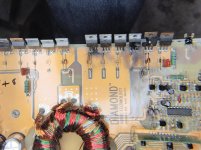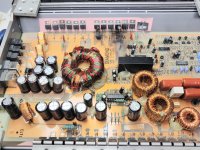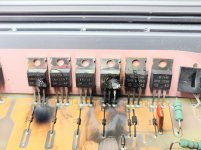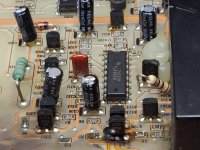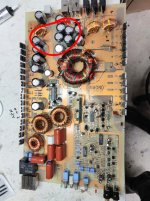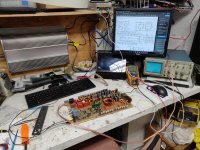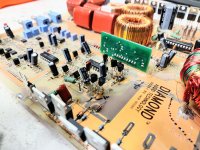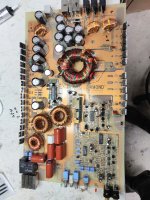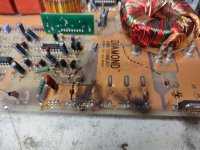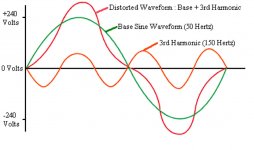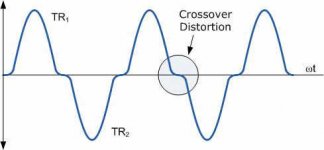I snagged a diamond audio d5 1200.1, and it showed up in the mail today. I bought it knowing that the power supply was burnt up, but it matches the d5 600.4 I fixed recently. So time to give it another shot.
This unit is class d. I can see several blown power supply fets for one side of the AC signal feeding the transformer. One of the driver transistors looks all burned up too. It drives the bank of fets that sn't all burned up.
I don't have a diagram for this amp, but I have diagrams for the
D5 600.2 and the 300.4. the power supply circuit, is similar but different.
The power supply fets are irfz44n.
Power supply driver transistors are
K218 C3198 GR several.
K213 A1266 GR several
Can I use mpsa06 and mpsa56 instead? I have many on hand
K222 A1268 GR x1
K220 C3200 GR x1
My plan is pull the rectifiers, replace the power supply driver transistors, replace the power supply fets and fate resistors, and see if she powers up. Good plan?
I did note that for the output fets, all are from the same batch, except for one. And it looks like cheap, poorly printed counterfeit. I was thinking I should go ahead and replace all of those while I am at it.
This unit is class d. I can see several blown power supply fets for one side of the AC signal feeding the transformer. One of the driver transistors looks all burned up too. It drives the bank of fets that sn't all burned up.
I don't have a diagram for this amp, but I have diagrams for the
D5 600.2 and the 300.4. the power supply circuit, is similar but different.
The power supply fets are irfz44n.
Power supply driver transistors are
K218 C3198 GR several.
K213 A1266 GR several
Can I use mpsa06 and mpsa56 instead? I have many on hand
K222 A1268 GR x1
K220 C3200 GR x1
My plan is pull the rectifiers, replace the power supply driver transistors, replace the power supply fets and fate resistors, and see if she powers up. Good plan?
I did note that for the output fets, all are from the same batch, except for one. And it looks like cheap, poorly printed counterfeit. I was thinking I should go ahead and replace all of those while I am at it.
I haven't tested anything in the output section yet. I don't know squat about how a class d works, so I gotta read up on em before I start poking around in the output. Everything looks good and clean there. More messing around tomorrow. Also, my El cheapo soldering iron died, so I have a slightly less so cheapo one coming in the mail.
If you're going to do this work, I'd suggest buying a good iron with true temperature control. I like the WES-51.
I didn't know what the K-numbers were for. It's a manufacturer code and not necessary when giving part numbers.
This amp is generally relatively easy to repair. Check the outputs before you order parts.
D5 1200.5? or 1200.1?
I didn't know what the K-numbers were for. It's a manufacturer code and not necessary when giving part numbers.
This amp is generally relatively easy to repair. Check the outputs before you order parts.
D5 1200.5? or 1200.1?
Yep, the iron on the way is temp adjustable and has a hot air component. Excited to learn to use another tool. (i have scrap electronics to practice on).
I ran through the output fets this morning with the multimeter, and they all seem to behave identically, and do not appear to be blown.
The PWM is a HIP4080A. So from looking at datasheets and example application diagrams of the PWM, it makes sense that all output fets are the same. It still irks me, as all I have read about the importance of having matching transistors, that all of the output fets except one seem to come from the same batch. And it doesn't appear that it was repaired in that section at all.
I may leave the outputs alone.
I ran through the output fets this morning with the multimeter, and they all seem to behave identically, and do not appear to be blown.
The PWM is a HIP4080A. So from looking at datasheets and example application diagrams of the PWM, it makes sense that all output fets are the same. It still irks me, as all I have read about the importance of having matching transistors, that all of the output fets except one seem to come from the same batch. And it doesn't appear that it was repaired in that section at all.
I may leave the outputs alone.
Adjustable doesn't mean temperature controlled but the one you're getting may be controlled.
When was the oddball output replaced?
I would replace all of the outputs if one is defective/different. The only good replacement that I've found is the IRF3710Z (<< Z is critical).
When was the oddball output replaced?
I would replace all of the outputs if one is defective/different. The only good replacement that I've found is the IRF3710Z (<< Z is critical).
There definitely is one that appears different, but it also doesn't look like anybody did any work there. Solder joints all look identical factory fresh.
I'll be out until after thanksgiving, but will be back to update this thread after parts arrive and I take a crack at the power supply side.
Thanks Perry for your input! Much appreciated. I'll also come back with a bunch of good pictures, as I love coming across threads with good complete pics.
I'll be out until after thanksgiving, but will be back to update this thread after parts arrive and I take a crack at the power supply side.
Thanks Perry for your input! Much appreciated. I'll also come back with a bunch of good pictures, as I love coming across threads with good complete pics.
Turkey coma wearing off. I got new power supply fets and loaded them up. Didn't tackle what looks like a bad driver transistor yet, but will try to get to that tonight. When I applied power after replacing power supply fets, I got a high pitch squeal from the capacitor area of the board. Protect light would flash. So I immediately removed power. Did not sound like transformer hum, or physical vibration, more like a cap was going to blow.
I'll replace driver transistors and check again. But I don't think my power supply woes are over yet. Can I test the large filter capacitors in circuit? I have a multimeter and a scope... I am nervous to leave power applied with the squeal.
edit: I tested the transformer coil for continuity between different wire colors, and was satisfied with my tests. And the other 3 large inductors look good as well, so I don't think I have any shorts.
I'll replace driver transistors and check again. But I don't think my power supply woes are over yet. Can I test the large filter capacitors in circuit? I have a multimeter and a scope... I am nervous to leave power applied with the squeal.
edit: I tested the transformer coil for continuity between different wire colors, and was satisfied with my tests. And the other 3 large inductors look good as well, so I don't think I have any shorts.
Last edited:
So I finished changing out power supply driver transistors (is that the right name for them?) And the amp came to life. No more protect light, green light! Tested it with the scope at various low frequencies, and it seems to work fine. Above 12.9v I do hear some of the aforementioned hiss. That concerns me, but nothing seems to be heating up on it. I don't have the equipment to really test it without hooking it up in my car.
So Major league blown power supply, replaced all power supply fets, and 4 transistors in the output section and it seems to be back in business.
What could be causing the hiss? Buffer capacitors about to die? Normal inductor hum? There are several good size ones...
So Major league blown power supply, replaced all power supply fets, and 4 transistors in the output section and it seems to be back in business.
What could be causing the hiss? Buffer capacitors about to die? Normal inductor hum? There are several good size ones...
Attachments
I've just watched it. I've heard the same noise in a lot of HIP4080 based amplifiers. But it is almost Inaudible when a sub is mounted in a box in the trunk of a car.
I'm sure it will be inaudible when closed up, and in the trunk. I should call out, that as I was unable to source a1266GR transistors, I pulled the paired C3198GR transistors out as well, and replaced with pairs of MPSA06 and MSPA56. I did have to twist legs around as the originals use a ECB 123 layout compared to the MPSxxx EBC 123 layout. But seems to work. We'll see how long it lasts.
@Perry, I don't blame you. If I could have back all the time I have wasted on bad videos, I'd feel like a younger man.
@Lenin, thanks for watching. I don't know what the HIP4080 output section could have to do with it, as it is coming from the power supply, well before power makes it to the output section.
Anyway, I have some cleanup to do on the heatsink to make it look nice again before I put it all back together.
Thank you Perry again for your help on this one.
@Perry, I don't blame you. If I could have back all the time I have wasted on bad videos, I'd feel like a younger man.
@Lenin, thanks for watching. I don't know what the HIP4080 output section could have to do with it, as it is coming from the power supply, well before power makes it to the output section.
Anyway, I have some cleanup to do on the heatsink to make it look nice again before I put it all back together.
Thank you Perry again for your help on this one.
Well, I'm back with this amp. I installed it and had it running at 2 ohm with a rated 400w rms subwoofer. It was working great, and sounding good. But that has stopped. sounded like a bang, and like it lost control of the subwoofer. I thought it might have overpowered the sub, and it bottomed out, but now I am not sure.
I hooked up another subwoofer to test, and when powered on, the sub immediately started making loud heavily distorted low frequencies. I threw it on the bench and opened it up, and put the scope on it. Intermittently it gives out very heavily distorted wave forms. I should have taken a picture. But when I got the camera ready, it stopped doing it, and was producing clean sine wave. I hooked the smaller sub up again, and it worked normally.
The amp powers up normally, and I get a green light. No protect.
The distorted waveform looked similar to a 3rd harmonic distortion waveform, like the red line in the image below, but the distorted waveform was unstable. Also, sometimes it would show some crossover distortion like the second picture. Other times, most of the time, it was a clean wave, and sounded clean. And less times, the waveform voltage would spike.
Something not right. Any help in diagnosing this issue?
I hooked up another subwoofer to test, and when powered on, the sub immediately started making loud heavily distorted low frequencies. I threw it on the bench and opened it up, and put the scope on it. Intermittently it gives out very heavily distorted wave forms. I should have taken a picture. But when I got the camera ready, it stopped doing it, and was producing clean sine wave. I hooked the smaller sub up again, and it worked normally.
The amp powers up normally, and I get a green light. No protect.
The distorted waveform looked similar to a 3rd harmonic distortion waveform, like the red line in the image below, but the distorted waveform was unstable. Also, sometimes it would show some crossover distortion like the second picture. Other times, most of the time, it was a clean wave, and sounded clean. And less times, the waveform voltage would spike.
Something not right. Any help in diagnosing this issue?
Attachments
Have you tried pushing/tapping on various parts of the amp to see if you could find an area that would make the problem(s) come/go? Also try pushing/pulling/twisting on all inductors and transformers.
Since the problem sounds like you're getting a full rail-rail output to the speaker, I'd recommend putting a limiter like a 120v incandescent bulb in series in one of the strands of speaker wires.
Since the problem sounds like you're getting a full rail-rail output to the speaker, I'd recommend putting a limiter like a 120v incandescent bulb in series in one of the strands of speaker wires.
You know, I did notice that when I applied a little bit of pressure to the board, that I got an occasional super high pitched very faint sound. But it didn't necessarily trigger or end the issue. I could push down on the board and hear it. Bad solder joint somewhere? I may have to go check my work on the power supply stuff I changed out. And carefully check all other joints for cracks.
I will try the light bulb trick.
I will try the light bulb trick.
- Status
- This old topic is closed. If you want to reopen this topic, contact a moderator using the "Report Post" button.
- Home
- General Interest
- Car Audio
- Diamond Audio d5 1200.5
